
Many states, agencies, and utilities are entrusted with translating equity policies and goals into actionable strategies in their policies and programs. In this case study, ILLUME shares valuable lessons from our work and provides a guide to taking preemptive steps that lay the groundwork for transformative change.
Introduction
What do you do when you have an end goal, but no pathway to get there? Three of ILLUME’s clients—two at the state-agency level and one at the utility level—were grappling with this challenge. In this case study, we discuss how to translate ambitious climate-equity mandates into actionable roadmaps to achieve equity goals. ILLUME guided our clients in constructing roadmaps for their unique environment to advance equity and pave the way for a clean energy future. With these tailored roadmaps in hand, our clients have an actionable path forward, metrics to measure success, and solutions rooted in the needs of the communities they serve.
The Challenge or Opportunity the Clients Faced
As the energy industry aims to reduce demand and decarbonize, electrification initiatives and programs are expanding among different states, utilities, and other entities. However, past program participation demonstrates that only a select few benefit from these investments, and in many cases, certain communities were harmed. In other words: equal energy services and solutions are not inherently equitable.
Many states, agencies, and utilities face a complicated policy imperative as they seek to intertwine energy and equity goals. To do so, these entities must determine how to advance equity in their energy programs and policies.

To ensure equitable energy programs and services, our clients were tasked with creating a roadmap for our industry that does not currently exist. The question becomes: how can we move forward to ensure an equitable energy transition?
Our clients approached ILLUME to pair data-driven solutions with authentic human insights. By incorporating both the lived human experience and quantitative analysis, ILLUME helped our clients identify their current state and create a vision and pathway for their equitable clean energy future.

Success Metric #1: Defining Priority Populations
The first critical step is answering a seemingly straightforward question: who are we trying to impact? This answer provides the priority population definition – in other words, it defines who has been and may continue to face inequities related to energy services. This process is client-specific—no two service territories are the same—but contains the same key ingredients. To define priority populations, ILLUME collected, synthesized, and analyzed all available data that might help define priority populations, spanning from census data to historic redlining data to public health data. Then, ILLUME convened community stakeholders to provide input on the key criteria to co-create the definitions of priority populations.
Want to see this in action? Look at New York State’s Disadvantaged Communities Criteria, which ILLUME led with New York State agencies and stakeholders.
Success Metric #2: Defining Equity and Equity Goals
Once priority populations are defined, the next step is to define what “equity” means. ILLUME worked with our clients to 1) understand the barriers customers face and their context (i.e., what problems have contributed to the ‘current state?’), then 2) define opportunities to address those barriers to advance equity. To do this, our team convened community stakeholders through focus groups, in-depth interviews, and public input sessions We sought to understand the perspectives of community stakeholders and answer “what does equitable service look like?” and determine what barriers customers have historically faced related to environmental and energy justice. ILLUME layered this stakeholder input into an understanding of the clients’ ‘sphere of influence’ to identify opportunities for the client to address barriers and advance equity. Where practicable, we aligned these insights with existing equity mandates at the state or federal level to create consistency across similar efforts and processes. Out of this, our clients had a clear definition—informed by impacted communities—of ‘equity’ and a set of goals to advance a more equitable energy future.
Want to see this in action? Look at how ILLUME supported ComEd to identify barriers to equitable service, and opportunities to address those barriers.
Success Metric #3: Methods to Drive Equity and Metrics to Measure It
Once priority populations are defined and a shared vision of ‘equity’ exists, organizations then need to create tactics to advance equity – and develop metrics to measure their progress. ILLUME works closely with our clients to develop equity metrics frameworks that clearly define what success looks like (i.e., what is the measurable ‘success’ metric?), establish methods to measure success (i.e., how do we quantify success?), and clarify a tactical strategy to get there (i.e., what approach will the client take to achieve it?). Combined, this framework provides an actionable roadmap to assess—and re-assess—progress toward advancing equity.
Want to see this in action? ILLUME is supporting the Connecticut Energy Efficiency Board to develop an equity metrics framework to measure equitable outcomes in conservation and load management programs. The first step of the process: assessing the current data available to measure equitable outcomes.
Overall Results
This holistic approach provides clients with an actionable and tactical way to advance equity in their communities. This is an inherently nuanced process; just like no two communities are identical, neither are their challenges and opportunities. By melding multiple data sources, authentic community engagement, and a deep understanding of the energy space, we help our clients create a clear roadmap to advance an equitable energy future.

Ready to advance energy equity in your communities? ILLUME is here to guide the way.
